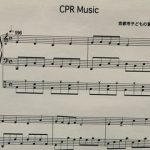CPR: You’re Never Too Young to Learn
I recently watched a YouTube video of a baby girl practicing CPR (cardiopulmonary resuscitation) on a CPR practice dummy and was inspired by her performance. The girl was still too young to actually walk so she scoots/crawls to the practice dummy in the middle of the floor. In the video you can hear her greet the dummy with a high-pitched baby style hello and when there is no response she proceeds to give chest compressions and blow in the practice dummy’s mouth.
Of course, her technique probably would not save a life but the inspiration is there and I felt compelled to share with you the importance of teaching family safety so that everyone grows up aware that we have the capability to save lives. It is likely that a person will find themselves in a situation someday that requires life saving skills, specifically CPR and it is vital that everyone has the proper training for that situation, should it arise.
We teach our children all kinds of safety precautions such as, looking both ways before crossing the street, don’t talk to strangers, how to dial 911 and even how to keep away from hot objects like the stove or fireplace. Teaching young children the basics of first aid and CPR is probably the most important life saving technique a person can be trained to perform. Just look at the statistics when it comes to heart disease in America and consider that people can experience cardiac arrest in all sorts of situations and circumstances.
 It is important that children learn at a young age that being trained in CPR is a valuable asset that could save the life of a stranger, a family member or a treasured friend. This value of protecting life and learning to be prepared can start being taught at young ages because it is more likely to last throughout the rest of their lives. The different circumstances and training we can give extend past CPR as well. For instance, being ready with the knowledge of emergency preparedness if a large-scale disaster should arise. The following is a quick list I have compiled of things to consider.
It is important that children learn at a young age that being trained in CPR is a valuable asset that could save the life of a stranger, a family member or a treasured friend. This value of protecting life and learning to be prepared can start being taught at young ages because it is more likely to last throughout the rest of their lives. The different circumstances and training we can give extend past CPR as well. For instance, being ready with the knowledge of emergency preparedness if a large-scale disaster should arise. The following is a quick list I have compiled of things to consider.
- Keep 72-hour kits for each family member that are ready to use
- Keep a first aid kit with all of the essentials and make sure it is easily accessible
- Store a three months supply of food and water in case of emergency
- Keep emergency numbers handy
- Practice fire, earthquake and other emergency drills with your family
- And of course the most important one of all make sure everyone in your family becomes CPR certified as soon as possible


